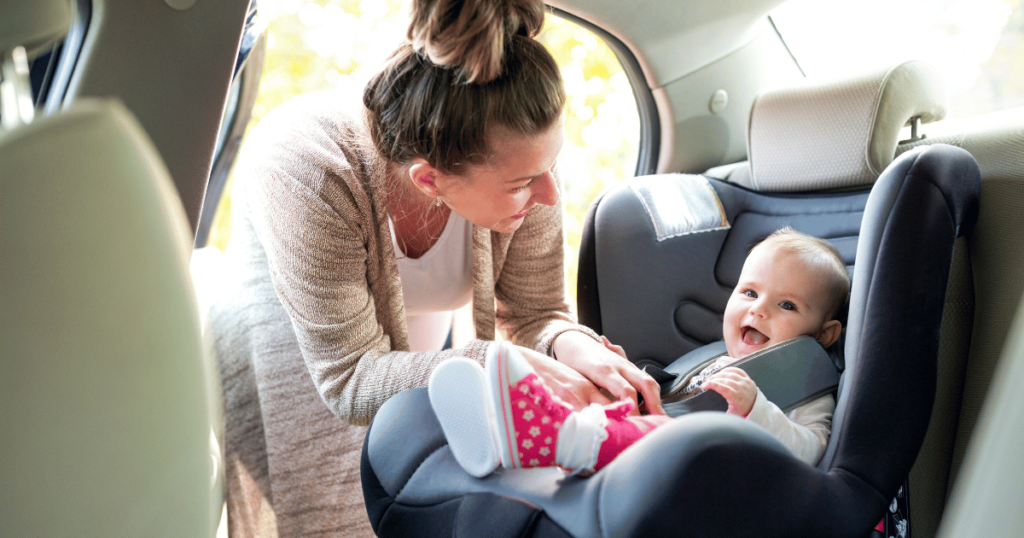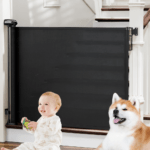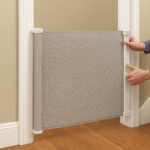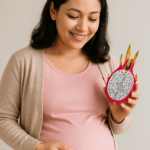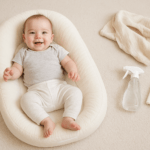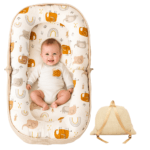When it comes to the safety and well-being of our little ones, every parent knows that keeping a baby cool in a car seat is a top priority. As temperatures rise, the risks of overheating become more prevalent, making it crucial for parents to adopt effective strategies for ensuring their baby’s comfort during car journeys.
Embarking on car journeys with your little one can be a joyous experience, but as responsible parents, ensuring your baby stays cool in the car seat becomes paramount. The sweltering heat can pose risks to your baby’s comfort and safety. This guide’ll explore comprehensive strategies, from choosing the right car seat to utilizing cooling devices to keep your baby comfortable during travels.
Let’s explore tips and tricks for making every car ride a breeze for you and your precious cargo.
Dangers of Overheating in Car Seats
Overheating in car seats is more than just discomfort; it poses severe risks to your baby’s well-being. Here are key points to consider:
- Heat-Related Illnesses: Prolonged exposure to high temperatures in a car seat can lead to heat-related illnesses such as heat exhaustion or, in extreme cases, heatstroke.
- Dehydration: Overheating increases the risk of dehydration, as your baby may sweat more to cool down. Insufficient hydration can lead to various health issues.
- Respiratory Distress: Elevated temperatures in a confined space can cause respiratory distress, making it harder for your baby to breathe comfortably.
- Increased Heart Rate: The body’s response to overheating includes an elevated heart rate, putting additional stress on your baby’s developing cardiovascular system.
- Discomfort and Irritability: Overheating leads to discomfort, making your baby irritable and fussy during car journeys, potentially leading to unsafe conditions.
- Risk of SIDS (Sudden Infant Death Syndrome): Prolonged exposure to high temperatures is associated with an increased risk of SIDS, making it crucial to maintain a comfortable environment for your baby.
Choosing the Right Car Seat
Selecting the appropriate car seat is the first step in safeguarding your baby from the heat. Look for features that enhance temperature regulation, such as breathable fabrics, proper ventilation, and compatibility with sunshades.
- Age and Size Compatibility:
- Choose a car seat for your baby’s age, weight, and height. Ensure it complies with the recommended guidelines for each developmental stage.
- Rear-Facing vs. Forward-Facing:
- Opt for a rear-facing seat for infants until they outgrow the manufacturer’s specifications. Transition to a forward-facing seat when age and size permit.
- Convertible Car Seats:
- Consider convertible car seats that adapt to different stages, accommodating rear and forward-facing positions. These provide longevity and value for money.
- Booster Seat Considerations:
- Assess the need for a booster seat for older children to ensure proper seatbelt positioning and safety. Booster seats elevate children to the correct height for seatbelt use.
- Safety Standards and Certification:
- Check for car seats meeting safety standards and certifications. Look for labels like FMVSS (Federal Motor Vehicle Safety Standards) and JPMA (Juvenile Products Manufacturers Association).
- Installation Ease:
- Ensure the car seat is user-friendly and compatible with your vehicle. Easy installation reduces the risk of errors that could compromise safety.
- Harness System and Adjustability:
- Opt for a car seat with a secure harness system, easily adjustable as your baby grows. Straps should fit snugly, with chest clips positioned at armpit level.
- LATCH System Compatibility:
- Verify compatibility with your vehicle’s LATCH (Lower Anchors and Tethers for Children) system to ensure a secure and straightforward installation.
- Energy-Absorbing Materials:
- Look for car seats with energy-absorbing materials, providing additional protection in a collision.
- Side-Impact Protection:
- Prioritize car seats with enhanced side-impact protection features, safeguarding your baby from potential injuries.
- Comfort Features:
- Consider additional comfort features, such as padded inserts, multiple recline positions, and breathable fabrics, ensuring a pleasant ride for your baby.
- Travel System Compatibility:
- If you use a stroller, check if the car seat is part of a travel system for seamless transitions between car and stroller.
- Weight and Portability:
- Evaluate the car seat’s weight, especially if you plan to move it frequently between vehicles or use it with a stroller.
- User Reviews and Ratings:
- Research user reviews and ratings to gain insights into other parents’ real-world performance and satisfaction with the chosen car seat model.
- Manufacturer’s Warranty:
- Check the manufacturer’s warranty to ensure coverage for potential defects and issues, providing added peace of mind.
Read to know more: Can you feed a baby in a car seat: Tips for On-the-Go Parents
Tips for Keeping Babies Cool in Car Seats

Keeping your baby cool and comfortable in a car seat is crucial, especially during hot weather. Here are some practical tips to ensure a pleasant and safe ride:
- Appropriate Clothing:
- Dress your baby in lightweight, breathable clothing. Avoid overdressing to prevent overheating.
- Avoid Heavy Blankets:
- Skip heavy blankets or quilts. Instead, use a light, breathable blanket if needed for added comfort.
- Breathable Fabrics and Accessories:
- Choose car seat accessories made from breathable fabrics. Opt for sunshades, seat covers, and cushions that allow proper airflow.
- Proper Ventilation:
- Ensure adequate ventilation by leaving a small gap in the car window or using the car’s air conditioning system judiciously.
- Sunshades and Window Tinting:
- Install sunshades on car windows and consider window tinting to reduce the direct impact of sunlight on your baby.
- Select Shaded Parking Spots:
- When parking, choose shaded areas to minimize the heat absorbed by the car and the car seat.
- Timing Matters:
- Plan your travels during more excellent parts of the day to avoid peak heat. Early mornings or late afternoons are ideal.
- Shorter Trips in Hot Weather:
- PlanPlan shorter trips during scorching weather to minimize your baby’s time in the car seat if possible.
- Frequent Stops:
- Make frequent stops during long journeys to check your baby’s comfort, provide shade, and ensure they stay well-hydrated.
- Hydration and Snacks:
- Offer cool drinks and snacks to keep your baby hydrated. Breastfeeding or providing formula can also help maintain hydration.
- Portable Fans and Mini Air Conditioners:
- Portable fans or mini air conditioners are designed for car use to enhance airflow around the car seat.
- Gel Packs and Cooling Cushions:
- Explore using gel packs or cooling cushions designed for car seats to provide additional relief.
- Recognize Signs of Discomfort:
- Pay attention to your baby’s cues. If they seem fussy, sweaty, or uncomfortable, take necessary measures to cool them down.
- Adjust Clothing as Needed:
- During the journey, be ready to adjust your baby’s clothing based on the changing temperature inside the car.
- Regular Cleaning and Maintenance:
- Keep the car seat clean and well-maintained for optimal ventilation. Check for any signs of wear and tear.
So, How can I make my infant car seat cooler?

- Use a Breathable Seat Cover:
- Invest in a car seat cover made from breathable materials, allowing air circulation and preventing heat buildup.
- Opt for Light-Colored Fabrics:
- Choose car seat accessories and covers in light colors. These reflect rather than absorb sunlight, helping to keep the seat cooler.
- Ventilation Inserts:
- Look for ventilation inserts designed for your specific car seat model. These inserts enhance airflow and prevent overheating.
- Install a Sunshade:
- Attach a sunshade to the car window to reduce direct sunlight on the car seat. Ensure it doesn’t obstruct your view while driving.
- Use a Cooling Pad or Cushion:
- Consider placing a cooling pad or cushion in the car seat. These accessories provide a refreshing surface for your baby to sit on.
- Frozen Gel Packs:
- Place frozen gel packs between the car seat and the cover. Wrap the packs in a thin cloth to avoid direct contact with your baby’s skin.
- Adjust Car Seat Position:
- Position the car seat strategically to avoid direct sunlight. Experiment with the seat’s placement to find the most fantastic spot in your vehicle.
- Portable Fans:
- Use small, battery-operated portable fans designed for strollers or car seats. Clip them onto the car seat to enhance airflow.
- Avoid Overdressing:
- Dress your infant in lightweight clothing to prevent overheating. Avoid heavy layers, mainly if the car seat cover provides warmth.
- Travel During Cooler Hours:
- Plan your journeys during the more excellent parts of the day, such as early morning or late afternoon, to reduce the overall temperature inside the car.
- Regular Stops for Checkups:
- Make frequent stops during long journeys to check your baby’s comfort. Use these breaks to provide shade and hydration.
- Tint Car Windows:
- Consider tinting your car windows to reduce the amount of sunlight entering the vehicle. Ensure compliance with local regulations regarding window tinting.
- Use Lightweight Blankets:
- If needed, use lightweight, breathable blankets instead of heavy ones. This allows for better airflow and prevents your baby from getting too warm.
- Check Car Ventilation:
- Ensure the car’s air conditioning system is functioning optimally. Regularly service your vehicle to maintain proper ventilation.
- Monitor Signs of Discomfort:
- Pay attention to signs of discomfort, such as fussiness or sweating. Adjust the environment accordingly to keep your infant comfortable.
What should a baby wear in a car seat in summer?
Dress your baby in lightweight, breathable clothing and avoid heavy blankets. Opt for accessories made from materials that allow airflow, ensuring your baby stays comfortable without compromising safety.
- Lightweight Clothing:
- Opt for lightweight, breathable clothing to prevent overheating. Onesies, rompers, or short-sleeved outfits are ideal choices.
- Avoid Overdressing:
- Resist the urge to overbundle your baby. Overdressing increases the risk of overheating, especially in the confined space of a car seat.
- Breathable Fabrics:
- Choose fabrics like cotton that allow air circulation, keeping your baby cool. Avoid synthetic materials that trap heat.
- Sun Hats:
- Protect your baby from direct sunlight with a wide-brimmed hat. Ensure it provides shade without obstructing their view.
- Sunglasses:
- If your baby tolerates them, consider baby-friendly sunglasses to shield their eyes from the sun’s glare.
- Light Blankets:
- If needed, use a light, breathable blanket. Avoid heavy blankets that can contribute to overheating.
- No Winter Coats:
- Remove bulky winter coats before securing your baby in the car seat. The harness should fit snugly against their body for optimal safety.
- Breathable Footwear:
- Choose breathable footwear or let your baby go barefoot if the car is at a comfortable temperature. Avoid shoes that might make their feet hot.
- Monitor Temperature:
- Regularly check your baby’s neck or back to ensure they’re not too hot. Adjust their clothing as needed based on the temperature inside the car.
Proper Car Seat Installation
Ensuring your baby’s car seat installation is paramount for their safety and comfort during travel. Adequate ventilation is crucial, as it prevents overheating. Additionally, check for compatibility with sunshades to shield your baby from direct sunlight, and carefully position the seat in the vehicle to minimize exposure to sun rays.
Timing and Planning
Smart timing and planning are key elements when traveling with your baby in the heat. Plan journeys to avoid peak heat hours, opting for shorter trips during hotter weather. Making frequent stops allows you to check your baby’s temperature and provide necessary relief from the heat.
Car Ventilation and Shade
Maintaining optimal airflow in the car is essential. Open windows strategically and use air conditioning judiciously to ensure a comfortable environment. Installing window shades and considering window tinting minimizes the impact of the sun, while choosing shaded parking spots adds an extra layer of protection.
Hydration and Snacks
Keeping your baby well-hydrated is crucial during car rides in warm weather. Offer cool drinks and snacks to regulate their body temperature, ensuring they remain comfortable throughout the journey.
Utilizing Cooling Devices
Incorporating cooling devices like portable fans, mini air conditioners, gel packs, and cooling cushions provides additional relief in warmer conditions. These devices help counteract the heat and maintain a more comfortable atmosphere for your baby.
Monitoring Baby’s Comfort
Constant vigilance is necessary to ensure your baby’s comfort. Pay attention to signs of discomfort, utilizing touch and visual cues to assess their temperature. Adjusting clothing or making stops as needed ensures a consistently comfortable environment during the journey.
Common Mistakes to Avoid
Avoid leaving your baby unattended in the car, overlook signs of overheating, or use inappropriate car seat accessories. These common mistakes can pose serious risks to your baby’s well-being.
Ensuring your baby stays comfortable in the car seat during warmer weather is crucial, but avoiding common mistakes could compromise their safety and well-being is equally important. Here are key pitfalls to steer clear of:
- Leaving a Baby Unattended:
- Never leave your baby unattended in the car, even for a short period. Cars can heat up rapidly, posing severe risks of overheating and dehydration.
- Overlooking Signs of Overheating:
- Be vigilant for signs of overheating, including excessive sweating, fussiness, flushed skin, or lethargy. Ignoring these cues can lead to serious health issues.
- Using Inappropriate Accessories:
- Avoid using aftermarket accessories not approved by the car seat manufacturer. These may compromise the seat’s safety features and put your baby at risk.
- Loose or Incorrect Harness Straps:
- Ensure the harness straps are snug and secure. Loose straps can be dangerous in the event of a collision, reducing the car seat’s effectiveness.
- Not Checking for Compatibility:
- Before purchasing accessories like seat covers or cooling pads, ensure they are compatible with your specific car seat model. Incorrect fits can affect safety features.
- Leaving the Car Seat in the Sun:
- Avoid leaving the car seat in direct sunlight, especially when not in use. The metal and plastic components can become excessively hot, causing discomfort to your baby.
- Using Heavy Blankets in Warm Weather:
- Skip heavy blankets in warm weather, as they can contribute to overheating. Choose lightweight, breathable blankets if necessary.
- Ignoring Proper Car Seat Installation:
- Take the time to install the car seat correctly. Incorrect installation can compromise safety features and increase the risk of injury during a collision.
- Skipping Regular Maintenance:
- Neglecting routine cleaning and maintenance can impede proper ventilation. Regularly inspect the car seat for wear and tear, ensuring it remains in optimal condition.
- Not Adjusting Clothing as Needed:
- Be attentive to your baby’s comfort during the journey. Adjust their clothing if they seem too warm, ensuring they stay cool and content.
- Disregarding Sunshade Use:
- Always use sunshades on car windows to shield your baby from direct sunlight. Prolonged exposure can lead to overheating and discomfort.
- Extended Travel During Peak Heat Hours:
- Plan your journeys to avoid peak heat hours, especially during scorching midday temperatures. Opt for travel in the cooler parts of the day.
- Ignoring Manufacturer Guidelines:
- Follow the manufacturer’s guidelines and recommendations for your specific car seat model. Deviating from these guidelines may compromise safety standards.
- Assuming All Car Seats Are Alike:
- Different car seats have unique features and safety specifications. Avoid assuming that what works for one seat applies to others. Read and follow the specific guidelines for your model.
- Not Educating Caregivers:
- Share your knowledge about keeping the baby cool in the car seat with caregivers and family members. Consistent practices ensure a safer travel environment for your baby.
Additional Tips for Extreme Heat

In extreme conditions, be prepared with emergency measures and seek professional advice for unique situations. Prioritize your baby’s safety above all else.
In the scorching heat of summer, safeguarding your baby from extreme temperatures in the car seat becomes paramount. Beyond the standard precautions, additional measures are essential for extreme heat conditions.
Always have an emergency kit equipped with water, ice packs, and essential supplies. Reflective sunshades can deflect sunlight, and dressing your baby in lightweight, breathable clothing is crucial. Consider cooling neck wraps and baby-safe mists for extra relief. Seeking professional advice in extreme conditions ensures personalized care. Limiting time in the car seat, strategically using ice packs, and planning routes with shaded areas are practical steps. Installing reflective window film and creating shade inside the car contribute to a cooler environment. Remember to stay informed about weather conditions, and if extreme heat warnings are issued, consider delaying non-essential travel. These additional precautions, tailored for extreme heat, prioritize your baby’s safety and comfort during challenging weather conditions.
Conclusion
In conclusion, ensuring your baby stays cool in the car seat is a fundamental aspect of responsible parenting. Following these guidelines and adopting proactive measures can create a safe and comfortable environment for your little one during car journeys.
Frequently Asked Questions
Can I use aftermarket accessories to cool the car seat?
It’s recommended to use accessories approved by the car seat manufacturer to ensure they meet safety standards.
How often should I stop during a long car journey with my baby?
Plan for breaks every 1-2 hours to check on your baby’s well-being and provide relief from the heat.
Are there specific car seat models designed for hot climates?
Some car seats have features tailored for temperature regulation; research and choose accordingly.
What are the signs that my baby may be overheating in the car seat?
Look for excessive sweating, fussiness, and flushed skin as potential signs of overheating.
Can I leave my baby alone in the car for a short period during cooler weather?
It’s never safe to leave a baby unattended in a car, regardless of the weather. Always take your baby with you.
